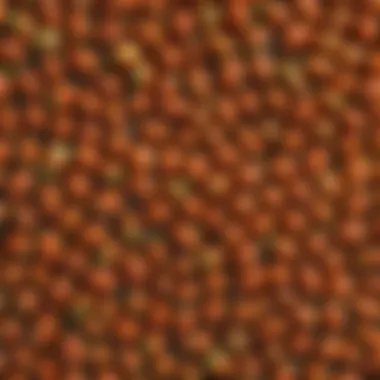Euphorbia Seeds: Cultivation, Ecology, and Sustainability


Intro
The exploration of Euphorbia seeds is both fascinating and essential for anyone involved in agriculture or horticulture. Euphorbia, a member of the diverse Euphorbiaceae family, includes a vast array of plants known for their adaptability and ecological significance. This family encompasses more than 2,000 species, ranging from small flowering plants to large shrubs and even trees. Understanding Euphorbia seeds is crucial for realizing their potential in sustainable agriculture and ecological management.
In this article, we will delve into the different dimensions of Euphorbia seeds, discussing their importance, cultivation techniques, and the various challenges faced by growers. We aim to equip agricultural professionals and enthusiasts with practical knowledge, ensuring effective management and cultivation of these unique seeds.
Overview of the Topic
Definition and Importance
Euphorbia seeds are the reproductive structures of plants within the Euphorbia genus. They serve various ecological roles, including providing food for wildlife and contributing to soil health. Many species possess unique adaptations that make them resilient in various environments, particularly in arid or semi-arid regions.
The importance of these seeds extends beyond their biological roles. Euphorbia species are often drought-resistant, making them valuable in sustainable agriculture practices, especially in climates facing water scarcity. Furthermore, their diverse adaptations can support biodiversity and stabilize ecosystems.
Current Trends
With increasing awareness of sustainable farming, the agricultural community is showing interest in Euphorbia seeds. Many researchers are studying their potential in crop rotation and intercropping systems, which can enhance soil fertility and reduce reliance on chemical fertilizers. There is also growing interest in native Euphorbia species for landscaping and ecological restoration.
Key Techniques and Practices
Step-by-Step Guide
Cultivating Euphorbia seeds requires careful attention to several factors:
- Seed Selection: Choose seeds based on local climate and soil conditions. Some popular species include Euphorbia tirucalli and Euphorbia milii.
- Soil Preparation: Ensure well-draining soil, as excessive moisture can lead to seed rot. It's often beneficial to add gravel or sand to improve drainage.
- Sowing: Plant seeds at a depth of about 1 to 2 inches. Space them adequately to allow for growth.
- Watering: Water gently and only when the top layer of soil feels dry.overwatering should be avoided.
- Temperature: Ensure seeds are kept in a warm location for optimal germination, typically between 70-80°F.
Tools and Equipment Needed
To cultivate Euphorbia seeds successfully, a few essential tools are necessary:
- Seedling trays or pots
- Well-draining potting mix
- Spray bottle for controlled watering
- Labels for tracking different species
Challenges and Solutions
Common Obstacles
While cultivating Euphorbia seeds can be rewarding, several challenges may arise:
- Slow Germination: Some seeds may have a prolonged germination period.
- Pest Infestation: Certain pests can target Euphorbia plants, impacting their growth.
- Disease: Fungal infections can occur if overly moist conditions persist.
Innovative Solutions
To overcome these challenges, consider the following solutions:
- Germination Techniques: Utilize scarification to enhance germination rates for tougher seed coats.
- Integrated Pest Management: Employ natural predators or organic pesticides to control pests.
- Fungal Treatments: Use fungicides or natural remedies to address disease while minimizing chemical exposure.
Understanding the dynamics of Euphorbia seeds not only promotes effective cultivation but also contributes to sustainable agricultural practices. This knowledge can empower agricultural professionals and enthusiasts to make informed decisions in their growing endeavors.
Foreword to Euphorbia
Euphorbia represents a significant genus within the extensive Euphorbiaceae family, characterized by a vast array of plant species that exhibit unique adaptations and ecological roles. Understanding Euphorbia is critical, not just for horticulturists and agriculturalists, but for anyone interested in the sustainability and biodiversity of our ecosystems. This section aims to lay the groundwork for the discussions that follow in this article, highlighting the relevance and implications of Euphorbia cultivation.
Overview of the Euphorbiaceae Family
The Euphorbiaceae family encompasses over 300 genera and more than 10,000 species of flowering plants. This family displays remarkable diversity, ranging from annual herbs to towering trees. One of the defining features of Euphorbiaceae is the presence of a milky latex, which can deter herbivores and pathogens, thus playing a vital role in the plant’s defense mechanism.
Euphorbia, specifically, includes an array of types, incorporating succulents, perennials, and even shrubs. The diversity within this family facilitates various ecological contributions and agricultural potential. For instance, many Euphorbia species are drought-resistant and can survive in adverse conditions, making them suitable for cultivation in arid regions. This versatility not only contributes to their popularity but also emphasizes their ecological significance in supporting biodiversity and habitat stability.
Diversity of Euphorbia Species
Diversity within the Euphorbia genus is vast, with species adapted to different environments around the world. Euphorbia milii, commonly called the crown of thorns, is appreciated for its hardy nature and attractive flowers, while Euphorbia tirucalli, or the pencil tree, is recognized for its unique structure and potential for use in landscaping.
The adaptability of Euphorbia species allows them to thrive in varied climates. Some species have evolved to excel in specific ecosystems, like deserts or tropical jungles, each presenting unique cultivation challenges and opportunities.
Understanding this diversity is crucial for anyone interested in effective cultivation practices. The specific requirements for each species regarding soil, water, and lighting must be considered to enhance successful growth and productivity.
"The diversity of Euphorbia species is a testament to nature’s ability to adapt, providing both ecological balance and potential agricultural benefits."


The Importance of Seeds in Euphorbia
Seeds play a vital role in the life cycle of Euphorbia species. They are the main means by which these plants reproduce and spread their genetic material. Understanding the importance of seeds allows for better cultivation practices and ecological management. Moreover, Euphorbia seeds are essential for maintaining biodiversity within different ecosystems. Their resilience and adaptive abilities help them thrive in various environments.
Reproductive Strategies
Euphorbia employs diverse reproductive strategies to ensure successful propagation. Most species are characterized by their high seed production, which increases the chances of germination and survival.
A number of Euphorbia species exhibit both sexual and asexual reproduction. Sexual reproduction involves the production of male and female flowers, which promote cross-pollination. This enhances genetic diversity. Conversely, some Euphorbia species can reproduce asexually through vegetative means, such as stem cuttings. This flexibility in reproduction allows Euphorbia to adapt to varying environmental conditions.
In addition to different modes of reproduction, the timing of seed release is crucial. Many species disperse their seeds during specific seasons to align with favorable growth conditions. Understanding these strategies enhances not only conservation efforts but also agricultural practices.
Seed Structure and Function
The structure of Euphorbia seeds is particularly engineered for resilience. These seeds are often hard-coated, offering protection against environmental stressors. This hard coat can delay germination until conditions are ideal, ensuring higher rates of success for seedlings.
The functional aspects of seeds also include nutrient storage. The endosperm serves as a food reserve, which supports the seedling during initial growth. This is especially important for Euphorbia species that may experience long periods of drought.
Additionally, some Euphorbia seeds have specialized adaptations, such as wing-like extensions or barbs, aiding in wind and animal dispersal. These adaptations contribute to their survival and establishment in new habitats.
"Understanding the anatomy and function of Euphorbia seeds is essential for effective cultivation techniques."
Overall, the study of Euphorbia seeds is not merely academic; it equips horticulturists and agricultural professionals with the tools to enhance seed viability and optimize growth conditions.
Cultivation of Euphorbia Seeds
Cultivating Euphorbia seeds is fundamental to maximizing the potential of these diverse species. The Euphorbiaceae family boasts a range of plants, each with unique growth traits, making them suitable for various agricultural and horticultural scenarios. Understanding the cultivation aspects ensures better management practices and contributes to the sustainable use of resources.
Selecting Appropriate Species
Choosing the right species of Euphorbia is vital for successful cultivation. Each species has its own set of characteristics, including climate preferences and soil requirements. Farmers and horticulturists should consider the following factors when selecting a species:
- Adaptability: Assess the climatic conditions of your region. Species such as Euphorbia tirucalli thrive in arid climates, while others may prefer more temperate conditions.
- Growth Habits: Some Euphorbia species grow as succulents, while others may act as groundcovers. Knowing the growth habits helps in planning the placement in a garden or farm.
- Commercial Value: Certain species, like Euphorbia pulcherrima, have high market demand, especially during the holiday season.
Researching these factors can enhance both yield and quality, making selection a critical step in cultivation.
Seed Viability and Testing
Evaluating the viability of Euphorbia seeds is crucial for successful planting. Seed viability directly affects germination rates, which in turn influences overall plant productivity. Here are methods to ensure seed viability:
- Visual Inspection: First, a basic inspection of seeds for damage or discoloration can provide initial indicators of quality.
- Float Test: Place seeds in water. Viable seeds typically sink, while non-viable seeds float.
- Germination Tests: A small sample of seeds can be planted in controlled conditions to assess germination rates. This step gives a more accurate understanding of what to expect during actual planting.
Ensuring high seed viability contributes to successful crop yields and can be the difference between thriving plants and a failed crop.
By focusing on these processes, agricultural professionals and enthusiasts can better position themselves for successful cultivation of Euphorbia seeds, leading to sustainable agricultural practices.
Soil and Environmental Requirements
The cultivation of Euphorbia seeds necessitates an understanding of specific soil and environmental conditions. These factors are fundamental to ensuring healthy growth and development of the plants. The quality of soil and its composition largely determine not only the germination of seeds but also the resilience of Euphorbia species against various stressors. Additionally, the adaptability to environmental conditions plays a crucial role in the selection of Euphorbia species suitable for different regions.
Soil Composition for Optimal Growth
The soil composition significantly impacts the growth and productivity of Euphorbia plants. Euphorbia species typically thrive in well-draining, sandy soils rich in organic matter. This type of soil prevents waterlogging which can lead to root rot. Key elements that should be present in optimal soil for Euphorbia include:
- pH Level: Euphorbia prefers a slightly acidic to neutral pH, ideally between 6.0 and 7.0.
- Nutrient Balance: A mixture of nitrogen, phosphorus, and potassium is essential. High nitrogen levels can promote excessive foliage but inhibit flowering.
- Organic Matter: Incorporating compost or well-rotted manure can enhance soil fertility.
Considerations also include ensuring that soil texture supports root establishment. Loamy soils with good aeration can enhance water retention while preventing compaction.
Climate Adaptability of Euphorbia Species
Euphorbia species display a remarkable adaptability to varying climatic conditions. Different species have distinct preferences, and understanding these can aid in effective cultivation.
- Temperature Tolerance: Many Euphorbia species show resilience to heat, needing warm temperatures to thrive, but also have varying tolerance to cold. For instance, Euphorbia tirucalli can withstand drought and high temperatures, whereas Euphorbia myrsinites prefers milder conditions.
- Humidity Requirements: While some Euphorbia plants can adapt to dry conditions, others require moderate humidity levels for optimal growth.
- Light Preferences: Most Euphorbia species prefer full sun conditions. However, some may tolerate partial shade without compromising their growth.
To achieve sustainable practices in Euphorbia cultivation, understanding the soil and environmental requirements is imperative. By aligning cultivation methods with these needs, farmers can improve yield and plant vitality.
Effective soil management and climate adaptability are pivotal in the success of Euphorbia cultivation.
Propagation Techniques for Euphorbia Seeds


Understanding propagation techniques for Euphorbia seeds is crucial for effective cultivation. These methods directly influence the successful growth of the plants, which can vary greatly among different species. Using the right techniques can enhance seed germination rates and improve overall plant health. Furthermore, knowing how to propagate correctly helps ensure the long-term survival of these diverse species, which have significant ecological and economic value.
Seed Sowing Methods
Sowing seeds properly is a fundamental step in the propagation process. Generally, the method depends on the species of Euphorbia being cultivated. Most Euphorbia seeds benefit from being sown in well-draining soil. Here are some key considerations:
- Soil Preparation: Use a potting mix that allows for adequate drainage. A mix with sand or perlite aids in preventing root rot.
- Seed Depth: Ideally, sow seeds at a depth of 1/8 to 1/4 inch. Deeper sowing can inhibit germination.
- Watering Methods: After sowing, lightly water the soil. It is essential to avoid over-saturation, which can lead to disease.
- Environment: Seeds prefer warm conditions; maintaining a temperature range of 70 to 85°F can boost germination efforts.
By adhering to these practices, cultivators increase the likelihood of successful germination and the establishment of strong seedlings.
Transplanting Seedlings
Once seedlings develop, carefully transplanting them ensures they continue to thrive. This step requires precision and attention to detail. Here's how to do it effectively:
- Timing: Wait until seedlings have a minimum of two sets of true leaves before transplanting. This typically indicates that they are strong enough to withstand the transition.
- Preparation: Prepare larger pots or garden beds to give the plants room to grow. Ensure these areas have similar soil conditions as the original growing medium.
- Technique: When transplanting, handle the seedlings by their leaves, avoiding pressure on the stems. This reduces stress on the seedlings.
- Watering After Transplant: Once in their new location, water gently to settle the soil around the roots.
- Acclimatization: If moving seedlings outdoors, gradually introduce them to full sun conditions to avoid shock, a practice also known as hardening off.
By utilizing these methods in both seed sowing and transplanting, gardeners can cultivate robust Euphorbia species that will prosper in different environments.
"Effective propagation of Euphorbia seeds not only supports home gardening but also contributes to biodiversity and ecological health."
For knowledge on various Euphorbia species and their specific requirements, you can explore Wikipedia.
Management Practices for Euphorbia Cultivation
Effective management practices are essential for the successful cultivation of Euphorbia species. These practices not only increase yield but also help to sustain the plant health over time. By understanding the specific needs and vulnerabilities of Euphorbia seeds, farmers can implement strategies to enhance growth and minimize losses. Important aspects of management practices include optimized irrigation strategies and controlling pests through integrated pest management techniques.
Irrigation Strategies
Irrigation is a critical component in the cultivation of Euphorbia seeds, having a direct effect on seed germination, growth rate, and overall health of the plants. It is essential to provide the right amount of water, as both overwatering and underwatering can lead to detrimental outcomes. Below are key considerations for irrigation strategies:
- Soil Moisture Monitoring: Regular monitoring of soil moisture can help determine when to irrigate. The goal is to keep the soil consistently moist but not waterlogged.
- Irrigation Timing: Early morning or late afternoon are the best times to irrigate to minimize evaporation loss. Avoid irrigating during the hottest part of the day.
- Irrigation Methods: Techniques such as drip irrigation are particularly beneficial for Euphorbia cultivation. This method provides water directly to the roots, reducing waste and encouraging deep root growth.
- Water Quality: Ensure that water quality meets acceptable standards. Poor quality water can introduce diseases and negatively influence the plants.
"Proper irrigation not only supports seed development but also enhances resilience against drought conditions."
Integrated Pest Management
Integrated Pest Management (IPM) offers a holistic approach to managing pests that affect Euphorbia species. The aim of IPM is to control pest populations while minimizing damage to the environment and reducing reliance on chemical pesticides. Key elements of IPM include:
- Regular Monitoring: Frequent inspections of plants help to catch pest issues early, allowing for quicker response.
- Cultural Practices: Practicing crop rotation and selecting resistant Euphorbia varieties can naturally reduce pest incidence.
- Biological Control: Utilizing natural predators or parasites can effectively control certain pest populations.
- Chemical Control: When necessary, using targeted pesticides in accordance with IPM principles can help to control infestations without harming beneficial insects.
Challenges in Euphorbia Seed Cultivation
The cultivation of Euphorbia seeds presents various challenges that farmers and horticulturists must navigate. Understanding these challenges is crucial for effective seed management and ensuring robust plant growth. Addressing pests, diseases, and environmental stress factors is essential for maintaining healthy crops and maximizing yield.
Pests and Diseases
Pests and diseases can significantly reduce the success of Euphorbia cultivation. These factors lead to poor seed germination and stunted plant growth. Some common pests include aphids, mealybugs, and spider mites. They can damage the leaves, stems, and seeds, making plants weak and susceptible to other problems.
Diseases such as root rot and powdery mildew often affect Euphorbia plants, especially in humid conditions. Breeding practices that include disease resistance can greatly benefit cultivation. Understanding your region's pest and disease prevalence can guide actions like crop rotation and the use of resistant varieties.
"Managing pest populations through timely identification and intervention is critical for successful Euphorbia cultivation."
Here are some strategies to manage pests and diseases:
- Regular Monitoring: Check plants frequently for signs of pest infestation or disease.
- Cultural Practices: Promote good air circulation and avoid overcrowding to reduce humidity, which favors diseases.
- Biological Control: Introduce beneficial insects to manage pest populations sustainably.
Environmental Stress Factors
Euphorbia species face various environmental stress factors that can hinder their growth. These factors include drought, extreme temperatures, and soil quality.
Drought is a major concern, especially in regions with low rainfall. Euphorbia species are often drought-resistant, but young seedlings need consistent moisture to establish roots. However, overwatering can lead to root rot, which is a fine balance to achieve.
Additionally, high temperatures can lead to physiological stress. Euphorbia plants can exhibit symptoms such as wilting and leaf drop if exposed to intense heat without sufficient water.
Soil quality is another critical factor in Euphorbia cultivation. Poor soil conditions can inhibit nutrient availability, affecting the overall health of the plants. Testing soil and amending it with organic material can improve its structure and nutrient content.
In summary, challenges in Euphorbia seed cultivation stem from pests, diseases, and environmental stress. Understanding these elements aids in developing strategies to optimize growth and seed success. This knowledge can lead to more sustainable practices, crucial for the agricultural community.
Euphorbia in Sustainable Agriculture


Euphorbia species, due to their diverse characteristics and adaptability, play a significant role in sustainable agriculture. Their inclusion in farming systems can enhance productivity while promoting ecological balance. This section highlights the various elements that make Euphorbia crucial in sustainable practices, addressing both benefits and considerations for their use in agriculture.
Role of Euphorbia in Biodiversity
Euphorbia species contribute to biodiversity by supporting various fauna and flora. Their unique adaptations allow them to thrive in a variety of climates and soils, making them candidates for restoring degraded ecosystems.
Some of the significant roles Euphorbia plays in promoting biodiversity include:
- Habitat for Wildlife: Euphorbia plants often provide shelter and food for various insects, birds, and other wildlife, aiding in ecosystem stability.
- Pollinator Attraction: Many Euphorbia species have evolved to attract specific pollinators, fostering a healthy environment for pollination.
- Soil Health: Their roots can improve soil structure and promote beneficial microorganisms, enhancing nutrient cycling.
"Euphorbia plants not only serve as a food source but also enhance the ecological connections within their habitats."
This biodiversity support allows for resilient agricultural systems, which are essential in the face of climate change and habitat loss.
Euphorbia as a Cover Crop
Using Euphorbia species as cover crops offers several advantages for sustainable farming. Cover crops prevent soil erosion, improve soil fertility, and suppress weeds. Their fast growth and unique root systems can effectively cover the soil, providing multiple benefits:
- Soil Protection: They shield the soil from erosion caused by wind and water, maintaining structural integrity.
- Nutrient Contribution: Certain Euphorbia species can fix nitrogen, enriching the soil for subsequent crops.
- Weed Suppression: The dense growth of Euphorbia can outcompete weeds, reducing the need for herbicides.
Farmers can select specific Euphorbia species based on their growth cycle and local conditions to optimize these benefits. This practice not only enhances soil health but also encourages sustainable crop rotation and farming techniques.
Overall, integrating Euphorbia into farming strategies presents a multifaceted approach to sustainable agriculture, enhancing productivity while fostering environmental stewardship.
Economic Value of Euphorbia Seeds
Euphorbia seeds hold significant economic value, reflecting their adaptability and versatility. They play a crucial role in both mainstream agriculture and niche markets. Understanding their value can help farmers and horticulturists make more informed decisions regarding cultivation practices, thereby enhancing their productivity and profit margins.
In recent years, the market for Euphorbia seeds has expanded. The increasing interest in sustainable agricultural practices bolsters this growth. Farmers are drawn to Euphorbia for its ability to thrive in adverse conditions. Additionally, many species are drought tolerant, making them viable in areas with limited water resources.
Market Demand and Cultivation Trends
The market demand for Euphorbia seeds is influenced by various factors. Firstly, environmental changes drive interest in plants that require less maintenance. As global climates change, cultivators look for resilient species. Euphorbia, with its diverse range, fits this need well.
Various Euphorbia species find their place in landscaping and ornamental gardening. As aesthetics become more important in urban areas, the demand increases. Plant nurseries often stock these seeds, highlighting a trend toward home gardening.
- Trends in Cultivation:
- Increased interest in sustainable and xeriscape gardening.
- Use of Euphorbia in container gardening, appealing to urban populations.
- Growing market for ornamental varieties, reflecting changing consumer preferences.
Given these trends, research into cultivation techniques focuses on improving yields. Advances in propagation strategies are becoming common to maximize the potential of these seeds.
Euphorbia in Traditional Medicine
Euphorbia seeds have a rich history in traditional medicine, utilized across various cultures. The seeds, and the plants themselves, often serve as herbal remedies. For example, some species are known for their anti-inflammatory properties. This has caught the attention of researchers exploring natural alternatives to chemical treatments.
Despite the medicinal uses, caution is necessary. Some Euphorbia species contain toxic compounds that can cause adverse reactions if misused. It is essential to have a proper understanding before using them medicinally.
- Key Considerations:
- Always consult healthcare professionals regarding medicinal use.
- Research is ongoing to better understand the pharmacological properties of different species.
Future Prospects for Euphorbia Cultivation
The field of Euphorbia cultivation harbors vast potential for both ecological and economic advancement. This section will explore crucial aspects that lie ahead in the realm of Euphorbia seeds. Genetic research and innovations in agronomy techniques are particularly significant elements that can enhance cultivation efficiency and improve the overall adaptation of Euphorbia species to various environments.
Genetic Research and Seed Improvement
Genetic research plays a vital role in enhancing the quality and performance of Euphorbia seeds. Understanding the genetic makeup of various Euphorbia species provides valuable insight that can lead to improved traits such as drought resistance, disease tolerance, and higher yields. Selecting and breeding superior strains with desired characteristics is becoming increasingly manageable through modern techniques like CRISPR and genomic selection.
Utilizing these methods can produce seeds that thrive in suboptimal conditions. The advantages include:
- Increased adaptability to changing climates.
- Enhanced resistance to pests and diseases.
- Better nutritional content in the plants produced.
Moreover, ongoing research into the genetic variation within Euphorbia species opens up possibilities for discovering new traits that could further benefit agriculture.
Innovations in Agronomy Techniques
In addition to genetic research, innovations in agronomy practices will play a pivotal role in shaping the future of Euphorbia cultivation. With advancements in technology, farmers can now adopt precision agriculture to optimize their cultivation efforts. This approach includes utilizing data analytics and sensors to monitor soil moisture, nutrient levels, and plant growth conditions.
Some potential techniques that might become mainstream include:
- Soil health management - Ensuring optimal soil health leads to better root development and improved seed germination rates.
- Integrated pest management - Employing biological control methods reduces chemical dependency, making practices more sustainable.
- Crop rotation and diversification - Including additional crops along with Euphorbia can enhance soil fertility and support biodiversity.
The future of Euphorbia cultivation is not just about improving the plants themselves but also refining the way we cultivate them.



